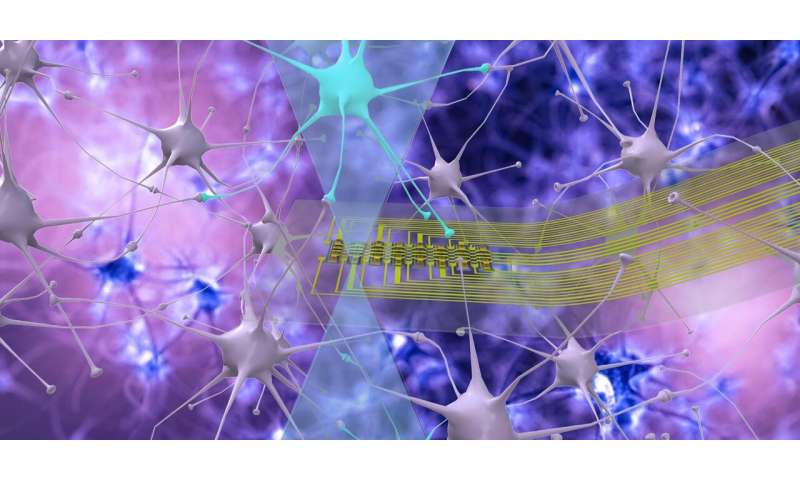Inventive design illuminates neurons deep in the brain

An interdisciplinary collaboration between researchers at Carnegie Mellon University has produced a new type of neural probe with an innovative design, improving the way researchers study neurons deep in the brain. The work, published in Frontiers in Neuroscience, combines CMU’s expertise in materials science, engineering and biological sciences to advance the field of neuroscience.
Neural probes are not new—scientists have been using these tools to record brain activity for years. When neurons are active, they generate an electrical signal which the probes can record. This allows them to decipher how neural circuits are formed and how neurons talk to each other. Modern neuroscience requires bi-direction neural probes, meaning that they can “write” as well as “read.” Using a technique called “optogenetics,” specific neurons can be stimulated using light from small light sources embedded in a neural probe.
The new probes developed in the Chamanzar Lab are bi-directional, and the first to use an integrated fabrication process that allows engineers to build many micro-light emitting diodes (microLEDs) directly on a flexible implantable neural probe. This is a big change from the way optical neural probes have traditionally been designed, with commercial microLEDs affixed to the probe later or implementing microLEDs on a stiff probe substrate that can damage the tissue.
“Off-the-shelf light sources have been used in the past and bonded to flexible neural probes,” said Maysam Chamanzar, assistant professor of electrical and computer engineering and a member of the Carnegie Mellon Neuroscience Institute, who led the work. “This usually involves a tedious process to flip-chip bond microLEDs one by one. Moreover, the microLEDs that you can purchase off the shelf are pretty large.”
To create the custom microLEDs, Chamanzar turned to Elias Towe, professor of electrical and computer engineering. Smaller than the width of a human hair, the new probes are made with a flexible, bio-compatible polymer base that causes less damage to brain tissue than traditional neural probes. The new design allows researchers to design any size or shape of microLEDS, including ones that can emit light from two sides, allowing for diverse patterns of neural stimulation.
Towe’s lab designed the device structure. Ibrahim Kimukin in Towe’s lab worked with Jay W. Reddy, a Ph.D. student in Chamanzar’s lab and first author on the paper, to fabricate and encapsulate the microLEDs.
“The integrated fabrication process opens so many design possibilities,” Reddy said. “Instead of a one-size-fits-all solution, we can make custom devices that address the needs of the neuroscience community.”
Another novel aspect of the probe design is the integrated architecture that enables massive scaling of the number of microLEDS and recording electrodes on the probe shank.
“Traditionally, there has always been a trade-off between the number of channels on a neural probe and the width of the probe,” Chamanzar said. “Our novel design for powering individual microLEDs in a matrix form enables us to maximize the read/write throughput without increasing the width of the probe and causing significant damage to the brain tissue.”
Partnering with biologists to create tools that address the outstanding technology needs in neuroscience is Chamanzar’s life’s work.
“We work with neuroscientists to understand the real needs in the application space, then build new devices that directly address those needs,” he said. “Our paper shows a true example of a fruitful collaboration between material scientists, engineers and neurobiologists to introduce a helpful tool to the neuroscience community.”
Alison Barth, the Maxwell C. and Gloria H. Connan Professor in the Life Sciences, and her lab developed protocols to see if the probes worked in brain tissue. They were able to show that activation of the microLEDs could trigger spiking in neurons close to the light source, providing a proof-of-concept for the fine-scale stimulation approach.
“We are actively working on identifying the fundamental properties of neural circuits,” she explained. “As we learn more, we may have very specific requirements for how we’d like to modulate individual types of neurons. These tools could be very useful for that.”
Source: Read Full Article



